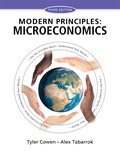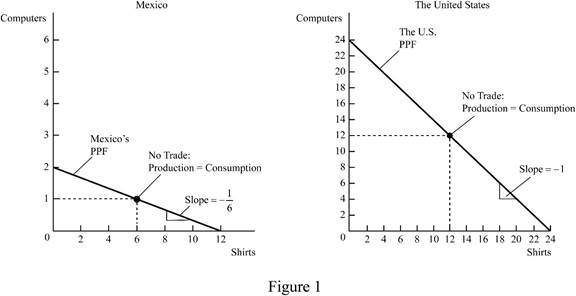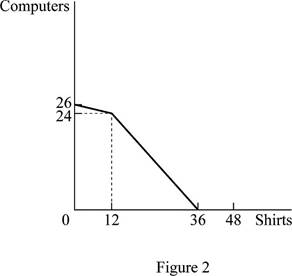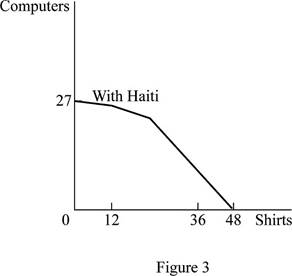
Subpart (a):
Production possibilities frontier of Mexico and United States.
Subpart (a):
Explanation of Solution
The production possibilities frontier of Mexico and United States is shown in Figure 1 below:
Figure 1 shows the

In Figure 1, the left side diagram shows PPF of Mexico and right side diagram shows the PPF of US. The vertical axis of both measures the number of computers produced by Mexico and United States, and the horizontal axis measures the number of shirts. Mexico produces 2 computers and 12 shirts, and United States produces 24 computers and 24 shirts.
Concept introduction:
Production possibilities frontier (PPF): PPF refers to the different combination of goods and services that can be produced efficiently with the given resources by a country. Any points inside the PPF represent inefficient usage of the resources, and any points outside the PPF represent that it is not attainable with the available resources.
Subpart (b):
Calculation of opportunity cost .
Subpart (b):
Explanation of Solution
The equation to calculate the opportunity cost is shown below.
Substitute the respective values in Equation (1) to calculate the opportunity cost of producing a shirt in Mexico.
Opportunity cost of producing a shirt in Mexico is 0.1666.
Substitute the respective values in Equation (1) to calculate the opportunity cost of producing a shirt in United States.
Opportunity cost of producing a shirt in United States is 1.
Mexico has to produce more number of shirts. This is because when comparing the opportunity cost of producing a shirt in both countries, Mexico has the lowest opportunity cost.
Concept introduction:
Opportunity cost: Opportunity cost refers to the value of forgone goods and services to consume the other goods and services.
Sub part (c):
Calculation of opportunity cost.
Sub part (c):
Explanation of Solution
Substitute the respective values in Equation (1) to calculate the opportunity cost of producing a computer in Mexico.
The opportunity cost of producing a computer in Mexico is 6.
Substitute the respective values in Equation (1) to calculate the opportunity cost of producing a computer in United States.
Opportunity cost of producing a computer in United States is 1.
United States has to produce more number of computers. This is because when comparing the opportunity of producing a computer in both countries, United States has the lowest opportunity cost.
Concept introduction:
Opportunity cost: Opportunity cost refers to the value of forgone goods and services to consume the other goods and services.
Sub part (d):
Production possibility frontier.
Sub part (d):
Explanation of Solution
On the basis of opportunity cost of producing a shirt and a computer in both countries, Mexico has a
Figure 2 shows the PPF of trade alliance between United States and Mexico.

In Figure 2, the vertical axis measures the volume of production of computers and the horizontal axis measures the volume of production of shirts. United States produces 24 units of computer and Mexico produces 1 unit. In the case of shirt, Mexico produces 12 units and United States produces 24 units.
Concept introduction:
Production possibilities frontier (PPF): PPF refers to the different combination of goods and services that can be produced efficiently with the given resources by a country. Any points inside the PPF represent inefficient usage of the resources, and any points outside the PPF represent that it is not attainable with the available resources.
Sub part (e):
Production possibility frontier.
Sub part (e):
Explanation of Solution
The trade alliance after the entrance of Haiti is shown below:
Figure 3 shows the PPF of trade alliance of Haiti, Mexico, and United States.

In Figure 3, the vertical axis measures the volume of production of computers and the horizontal axis measures the volume of production of shirts. This is the new PPF after the trade alliance of Haiti with the trade alliance between Mexico and United States. Haiti is producing 1 unit of computer and 12 units of shirt.
Concept introduction:
Production possibilities frontier (PPF): PPF refers to the different combination of goods and services that can be produced efficiently with the given resources by a country. Any points inside the PPF represent inefficient usage of the resources, and any points outside the PPF represent that it is not attainable with the available resources.
Sub part (f):
Production possibility frontier.
Sub part (f):
Explanation of Solution
The PPF of trade alliance of existing three countries and many countries who join the trade alliance is shown below.
Figure 4 shows the PPF for trade alliance between infinity numbers of countries.

In Figure 4, the vertical axis measures the volume of production of computers and the horizontal axis measures the volume of production of shirts. The first curve represents that PPF is the trade alliance between Mexico and United States. The second curve represents that PPF is the trade alliance between Mexico, United States with Haiti. The third curve represents the PPF of trade alliance between infinity numbers of countries.
Concept introduction:
Production possibilities frontier (PPF): PPF refers to the different combination of goods and services that can be produced efficiently with the given resources by a country. Any points inside the PPF represent inefficient usage of the resources, and any points outside the PPF represent that it is not attainable with the available resources.
Want to see more full solutions like this?
Chapter 2 Solutions
EBK MODERN PRINCIPLES OF MICROECONOMICS
- Your marketing department has identified the following customer demographics in the following table. Construct a demand curve and determine the profit maximizing price as well as the expected profit if MC=$1. The number of customers in the target population is 10,000. Use the following demand data: Group Value Frequency Baby boomers $5 20% Generation X $4 10% Generation Y $3 10% `Tweeners $2 10% Seniors $2 10% Others $0 40%arrow_forwardYour marketing department has identified the following customer demographics in the following table. Construct a demand curve and determine the profit maximizing price as well as the expected profit if MC=$1. The number of customers in the target population is 10,000. Group Value Frequency Baby boomers $5 20% Generation X $4 10% Generation Y $3 10% `Tweeners $2 10% Seniors $2 10% Others $0 40% ur marketing department has identified the following customer demographics in the following table. Construct a demand curve and determine the profit maximizing price as well as the expected profit if MC=$1. The number of customers in the target population is 10,000.arrow_forwardTest Preparation QUESTION 2 [20] 2.1 Body Mass Index (BMI) is a summary measure of relative health. It is calculated by dividing an individual's weight (in kilograms) by the square of their height (in meters). A small sample was drawn from the population of UWC students to determine the effect of exercise on BMI score. Given the following table, find the constant and slope parameters of the sample regression function of BMI = f(Weekly exercise hours). Interpret the two estimated parameter values. X (Weekly exercise hours) Y (Body-Mass index) QUESTION 3 2 4 6 8 10 12 41 38 33 27 23 19 Derek investigates the relationship between the days (per year) absent from work (ABSENT) and the number of years taken for the worker to be promoted (PROMOTION). He interviewed a sample of 22 employees in Cape Town to obtain information on ABSENT (X) and PROMOTION (Y), and derived the following: ΣΧ ΣΥ 341 ΣΧΥ 176 ΣΧ 1187 1012 3.1 By using the OLS method, prove that the constant and slope parameters of the…arrow_forward
- QUESTION 2 2.1 [30] Mariana, a researcher at the World Health Organisation (WHO), collects information on weekly study hours (HOURS) and blood pressure level when writing a test (BLOOD) from a sample of university students across the country, before running the regression BLOOD = f(STUDY). She collects data from 5 students as listed below: X (STUDY) 2 Y (BLOOD) 4 6 8 10 141 138 133 127 123 2.1.1 By using the OLS method and the information above derive the values for parameters B1 and B2. 2.1.2 Derive the RSS (sum of squares for the residuals). 2.1.3 Hence, calculate ô 2.2 2.3 (6) (3) Further, she replicates her study and collects data from 122 students from a rival university. She derives the residuals followed by computing skewness (S) equals -1.25 and kurtosis (K) equals 8.25 for the rival university data. Conduct the Jacque-Bera test of normality at a = 0.05. (5) Upon tasked with deriving estimates of ẞ1, B2, 82 and the standard errors (SE) of ẞ1 and B₂ for the replicated data.…arrow_forwardIf you were put in charge of ensuring that the mining industry in canada becomes more sustainable over the course of the next decade (2025-2035), how would you approach this? Come up with (at least) one resolution for each of the 4 major types of conflict: social, environmental, economic, and politicalarrow_forwardHow is the mining industry related to other Canadian labour industries? Choose one other industry, (I chose Forestry)and describe how it is related to the mining industry. How do the two industries work together? Do they ever conflict, or do they work well together?arrow_forward
- What is the primary, secondary, tertiary, and quaternary levels of mining in Canada For each level, describe what types of careers are the most common, and describe what stage your industry’s main resource is in during that stagearrow_forwardHow does the mining industry in canada contribute to the Canadian economy? Describe why your industry is so important to the Canadian economy What would happen if your industry disappeared, or suffered significant layoffs?arrow_forwardWhat is already being done to make mining in canada more sustainable? What efforts are being made in order to make mining more sustainable?arrow_forward
- What are the environmental challenges the canadian mining industry face? Discuss current challenges that mining faces with regard to the environmentarrow_forwardWhat sustainability efforts have been put forth in the mining industry in canada Are your industry’s resources renewable or non-renewable? How do you know? Describe your industry’s reclamation processarrow_forwardHow does oligopolies practice non-price competition in South Africa?arrow_forward

 Principles of Economics (12th Edition)EconomicsISBN:9780134078779Author:Karl E. Case, Ray C. Fair, Sharon E. OsterPublisher:PEARSON
Principles of Economics (12th Edition)EconomicsISBN:9780134078779Author:Karl E. Case, Ray C. Fair, Sharon E. OsterPublisher:PEARSON Engineering Economy (17th Edition)EconomicsISBN:9780134870069Author:William G. Sullivan, Elin M. Wicks, C. Patrick KoellingPublisher:PEARSON
Engineering Economy (17th Edition)EconomicsISBN:9780134870069Author:William G. Sullivan, Elin M. Wicks, C. Patrick KoellingPublisher:PEARSON Principles of Economics (MindTap Course List)EconomicsISBN:9781305585126Author:N. Gregory MankiwPublisher:Cengage Learning
Principles of Economics (MindTap Course List)EconomicsISBN:9781305585126Author:N. Gregory MankiwPublisher:Cengage Learning Managerial Economics: A Problem Solving ApproachEconomicsISBN:9781337106665Author:Luke M. Froeb, Brian T. McCann, Michael R. Ward, Mike ShorPublisher:Cengage Learning
Managerial Economics: A Problem Solving ApproachEconomicsISBN:9781337106665Author:Luke M. Froeb, Brian T. McCann, Michael R. Ward, Mike ShorPublisher:Cengage Learning Managerial Economics & Business Strategy (Mcgraw-...EconomicsISBN:9781259290619Author:Michael Baye, Jeff PrincePublisher:McGraw-Hill Education
Managerial Economics & Business Strategy (Mcgraw-...EconomicsISBN:9781259290619Author:Michael Baye, Jeff PrincePublisher:McGraw-Hill Education





